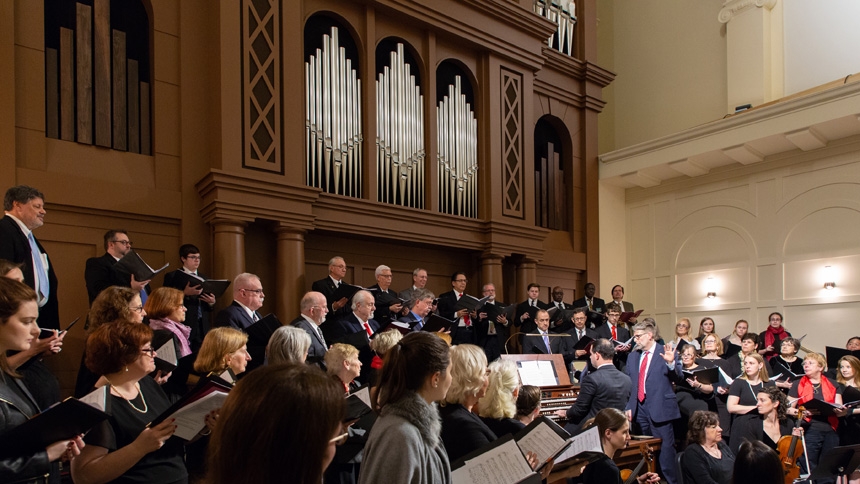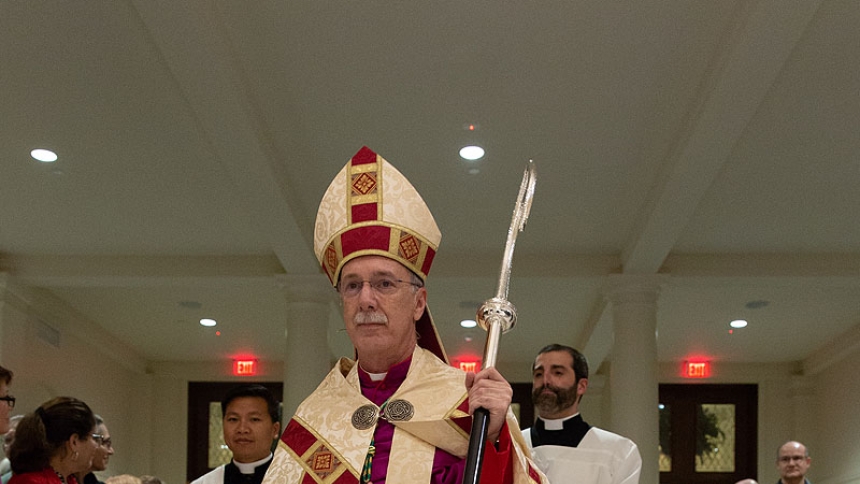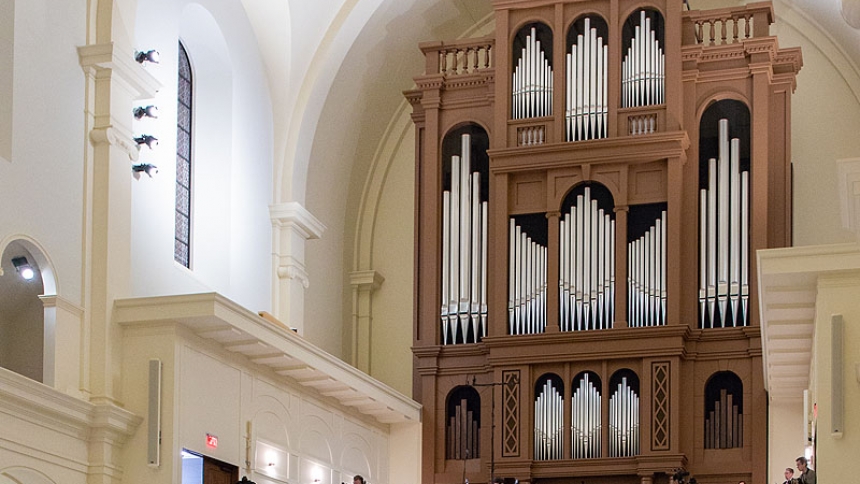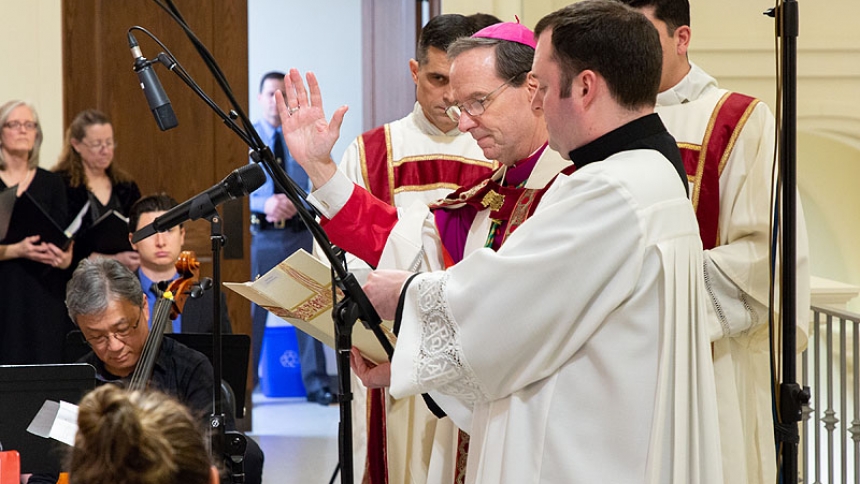
It was already standing-room only inside the 2,000-seat cathedral. As people filed through the front doors of the Raleigh church, clergy, donors, builders and committee members responsible for bringing an organ with 3,737 pipes to the cathedral gathered quietly in the 50-seat chapel for photos.
Cathedral architect Jim O’Brien was there. Michael Accurso, director of Music and Liturgy for the diocese, was too. O’Brien had a question for Accurso, who would – later in the evening – play the newly-blessed pipe organ as thousands listened to an original hymn he composed.
“Are you nervous?” O’Brien asked.
Accurso smiled and answered, “My hands are as steady as your foundation.”
Somehow, that light-hearted exchange seemed to balance perfectly with the blessing of a 22.5-ton pipe organ, which sits in the cathedral’s choir loft.
The pipe organ’s blessing date – Jan. 3 – carried significance. Bishop Michael Burbidge, former bishop of Raleigh, first broke ground for Holy Name of Jesus Cathedral four years ago on Jan. 3, which is the feast day of the Holy Name of Jesus in the Catholic Church.
The cathedral itself was dedicated in July 2017, but, because of even small amounts of construction dust, a waiting period was necessary before the pipe organ could be installed, a project that began in February 2018 and finished just days before the Jan. 3 blessing, which was part of Solemn Vespers.
Bishop Luis Rafael Zarama, Raleigh’s bishop, presided. Bishop Burbidge, of Arlington, Virginia, blessed the C.B. Fisk Opus 147, the official name of the pipe organ which nods to the Gloucester, Mass., company that crafted the instrument.
Builder Dana Sigall, of C.B. Fisk, attended vespers with about 15 other Fisk representatives. Walking in, Sigall paused halfway down the aisle and paused to look, not at the pipe organ he helped construct and assemble, but at the standing-only crowd that was there to enjoy the fruit of his labor.
“When we do the work, we know we’re not just working for ourselves. There’s nothing like seeing the people who come to hear it and see it, to experience it through their eyes and ears,” he said.
For Sigall, the beauty that can be produced is everything that matters. Looking up toward the loft he added, “It’s just a machine – a big clap-trap – until there’s music, right?”
In his homily, Bishop Zarama first thanked Bishop Burbidge. “Sometimes miracles are made possible because of people,” he said. “We are here because of Bishop Mike Burbidge.”
Messages of gratitude continued throughout the homily; he thanked the builders for their precision and masterful construction, he thanked the nearly 2,500 people who gathered for the evening and he thanked those who made the pipe organ possible.
“Someone who liked music and liked to pray was able to say, ‘I will do that. I will put something special there that through the music, you can raise your hearts to praise God for the good things and for the times you cry.’ The instrument will help us pray,” he said.
Following the homily, Bishop Burbidge processed to the choir loft to bless the Fisk Opus 147. The congregation turned around to witness the historic event.
Immediately following the blessing, the moment Accurso and O’Brien chatted about finally arrived, and the congregation remained facing the choir loft as Accurso played his original composition, “I Will Praise Your Name Forever,” which was commissioned for the building of Holy Name of Jesus Cathedral.
For the first time, the majesty of the pipes of the Fisk Opus 147 flooded the cathedral with music of overwhelming depth and harmony.
Tears brimmed in the eyes of those who had been looking forward to this, the opportunity to praise God with an instrument of almost unbelievable capabilities.
The magnitude of the pipe organ was underscored by Nathan Laube, a world-renowned musician who performed a concert following vespers.
Despite being on the faculty of the Eastman School of Music and the International Consultant in Organ Studies at the Royal Birmingham Conservatoire in the U.K., Laube spent more than 30 hours with the Fisk Opus 147 prior to the dedicatory recital.
“Each organ is unique,” Laube said. “This one has over 70 stops. It’s like conducting an orchestra of 70 players, and the acoustics of a place, like in this cathedral, offer even more opportunities.”
Laube compared playing the organ to sculpting a statue and to being an artist with a near limitless palette of colors. As he sat down to play, those descriptions came to life.
Sitting on the organ bench, he regarded the panel before him and perched his hands just above the keys. He sat for a moment before playing, his fingers leaping and gliding in silent subtle movements as though he were running through what he was about to play, like a sculptor regarding a block of granite and seeing the end result before his first strike.
Then, he played. The room filled with notes so high they lilted as though dancing upon the lights above and with tones so low they were only perceptible in the vibrations felt, rather than heard.
Laube’s feet danced across the pedals with Fred Astaire-like grace and his fingers flew across the keys like a master concert pianist. Though most people present did not get to see Laube play as he sat aloft and behind them, their senses witnessed the beauty of his work.
After the blessing and recital, attendees waited in line to greet Laube, Bishop Burbidge and Bishop Zarama. Voices of appreciation and mirth filled the narthex as the cathedral bells pealed, allowing joyful song to accompany visitors to their cars.
Watch Bishop Zarama's homily








